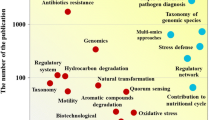Abstract
A Gram-negative, aerobic, non-motile bacterial strain hun6T isolated from the polluted soil near a chemical factory in northern Nanjing, China was investigated to clarify its taxonomic position. Growth of strain hun6T occurred between 10 and 45 °C (optimum, 30 °C) and between pH 6.0 and 8.0 (optimum, pH 7.0). No growth occurred at NaCl concentrations greater than 5 % (w/v). The 16S rRNA gene sequence analysis indicated that strain hun6T belongs to the genus Aquamicrobium. The sequence similarities of strain hun6T to other type strains of Aquamicrobium genus were all below 98.5 %. The presence of ubiquinone-10, the predominant fatty acid summed feature 8 (C18:1 ω7c and/or C18:1 ω6c) and C19:0 cyclo ω8c, a polar lipid pattern with phosphatidylglycerol, phosphatidylcholine, diphosphatidylglycerol, phosphatidylethanolamine and phophatidylmonomethylethanoamine were in accord with the characteristics of the genus Aquamicrobium. The G+C content of the genomic DNA was determined to be 63.5 mol%. The results of DNA–DNA hybridization, physiological and biochemical tests and chemotaxonomic properties allowed genotypic and phenotypic differentiation of strain hun6T from all known Aquamicrobium species. Therefore, strain hun6T can be assigned to a new species of this genus for which the name Aquamicrobium terrae sp. nov. is proposed. The type strain is hun6T (= CICC 10733T = DSM 27865T).

Similar content being viewed by others
References
Altenburger P, Kampfer P, Makristathis A, Lubitz W, Busse HJ (1996) Classification of bacteria isolated from a medieval wall painting. J Biotechnol 47:39–52
Bambauer A, Rainey F, Stackebrandt E, Winter J (1998) Characterization of Aquamicrobium defluvii gen. nov. sp. nov., a thiophene-2-carboxylate-metabolizing bacterium from activated sludge. Arch Microbiol 169:293–302
Beveridge TJ, Lawrence JR, Murray RGE (2007) Sampling and staining for light microscopy. In: Reddy CA, Beveridge TJ, Breznak JA, Marzluf GA, Schmidt TM, Snyder RL (eds) Methods for general and molecular 208 microbiology, 3rd edn. American Society for Microbiology, Washington, DC, pp 19–33
Busse HJ, Auling G (1988) Polyamine pattern as a chemotaxonomic marker within the Proteobacteria. Syst Appl Microbiol 11:1–8
Busse HJ, Bunka S, Hensel A, Lubitz W (1997) Discrimination of members of the family Pasteurellaceae based on polyamine patterns. Int J Syst Bacteriol 47:698–708
Collins MD (1985) Isoprenoid quinone analysis in classification and identification. In: Goodfellow M, Minnikin DE (eds) Chemical methods in bacterial systematics. Academic Press, London, pp 267–287
Ezaki T, Hashimoto Y, Yabuuchi E (1989) Fluorometric deoxyribonucleic acid-deoxyribonucleic acid hybridization in microdilution wells as an alternative to membrane filter hybridization in which radioisotopes are used to determine genetic relatedness among bacterial strains. Int J Syst Bacteriol 39:224–229
Felsenstein J (1985) Confidence limits on phylogenies: an approach using the bootstrap. Evolution 39:783–791
Fritsche K, Auling G, Andreesen JR, Lechner U (1999) Defluvibacter lusatiensis corrig., sp. nov. In Validation of Publication of New Names and New Combinations Previously Effectively Published Outside the IJSB, List no. 71. Int J Syst Bacteriol 49:1325–1326
Gomori G (1955) Preparation of buffers for use in enzyme studies. In: Colowick SP, Kaplan NO (eds) Methods in Enzymology, vol 1. Academic Press, New York, pp 138–146
Hyun MJ, Kim JM, Jeon CO (2013) Aquamicrobium aestuarii sp. nov., a marine bacterium isolated from a tidal flat of Yellow Sea. Int J Syst Evol Microbiol 63:4012–4017
Kämpfer P, Martin E, Lodders N, Jäckel U (2009) Transfer of Defluvibacter lusatiensis to the genus Aquamicrobium as Aquamicrobium lusatiense comb. nov. and description of Aquamicrobium aerolatum sp. nov. Int J Syst Evol Microbiol 59:2468–2470
Lányí B (1987) Classical and rapid identification methods for medically important bacteria. Methods Microbiol 19:1–67
Lechner U, Baumbach R, Becker D, Kitunen V, Auling G, Salkinoja-Salonen M (1995) Degradation of 4-chloro-2-methylphenol by an activated sludge isolate and its taxonomic description. Biodegradation 6:83–92
Lipski A, Kämpfer P (2012) Aquamicrobium ahrensii sp. nov and Aquamicrobium segne sp. nov. from experimental biofilters. Int J Syst Evol Microbiol 62:2511–2516
Marmur J (1961) A procedure for the isolation of deoxyribonucleic acid from microorganisms. J Mol Biol 3:208–218
Mesbah M, Premachandran U, Whitman WB (1989) Precise measurement of the G+C content of deoxyribonucleic acid by high-performance liquid chromatography. Int J Syst Bacteriol 39:159–167
Miller AS, Dykes DD, Polesky FH (1988) A simple salting out procedure for extracting DNA from human nucleated cells. Nucleic Acids Res 16:1215
Sasser M (1990) Identification of bacteria by gas chromatography of cellular fatty acids. USFCC Newslett 20:1–6
Tamura K, Peterson D, Peterson N, Stecher G, Nei M, Kumar S (2011) MEGA5: molecular evolutionary genetics analysis using maximum likelihood, evolutionary distance, and maximum parsimony methods. Mol Biol Evol 28:2731–2739
Tindall BJ (1990) Lipid composition of Halobacterium lacusprofundi. FEMS Microbiol Lett 66:199–202
Wayne LG, Brenner DJ, Colwell RR, Grimont PAD, Kandler O, Krichevsky MI, Moore LH, Moore WEC, Murray RGE, Stackebrandt E, Starr I, Truper HG (1987) International committee on systematic bacteriology. Report of the ad hoc committee on reconciliation of approaches to bacterial systematics. Int J Syst Bacteriol 37:463–464
Wu ZG, Zhang DF, Liu YL, Wang F, Jiang X, Li C, Li SP, Hong Q, Li WJ (2013) Paracoccus zhejiangensis sp. nov., isolated from activated sludge in wastewater-treatment system. Antonie Van Leeuwenhoek 104:123–128
Acknowledgments
This work was financially supported by the National Key Basic Research Program of China (No. 2014CB441105), the National Natural Science Foundation of China (41030531, 21277148), the Natural Science Foundation of Tianjin (No. 08JCZDJC15600), the Postdoctoral Special Support of China (No.2013T60568) and the National Postdoctoral Foundation of China (No. 2013M541745).
Author information
Authors and Affiliations
Corresponding authors
Electronic supplementary material
Below is the link to the electronic supplementary material.
Rights and permissions
About this article
Cite this article
Wu, ZG., Wang, F., Gu, CG. et al. Aquamicrobium terrae sp. nov., isolated from the polluted soil near a chemical factory. Antonie van Leeuwenhoek 105, 1131–1137 (2014). https://doi.org/10.1007/s10482-014-0174-8
Received:
Accepted:
Published:
Issue Date:
DOI: https://doi.org/10.1007/s10482-014-0174-8




